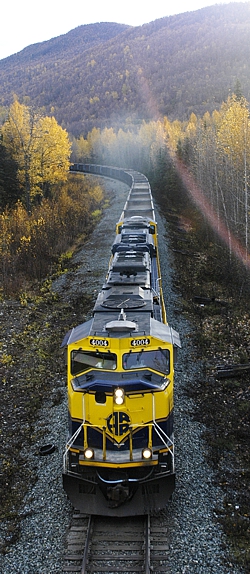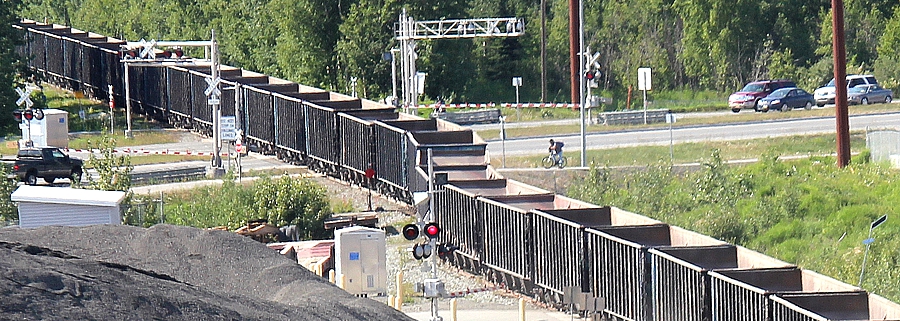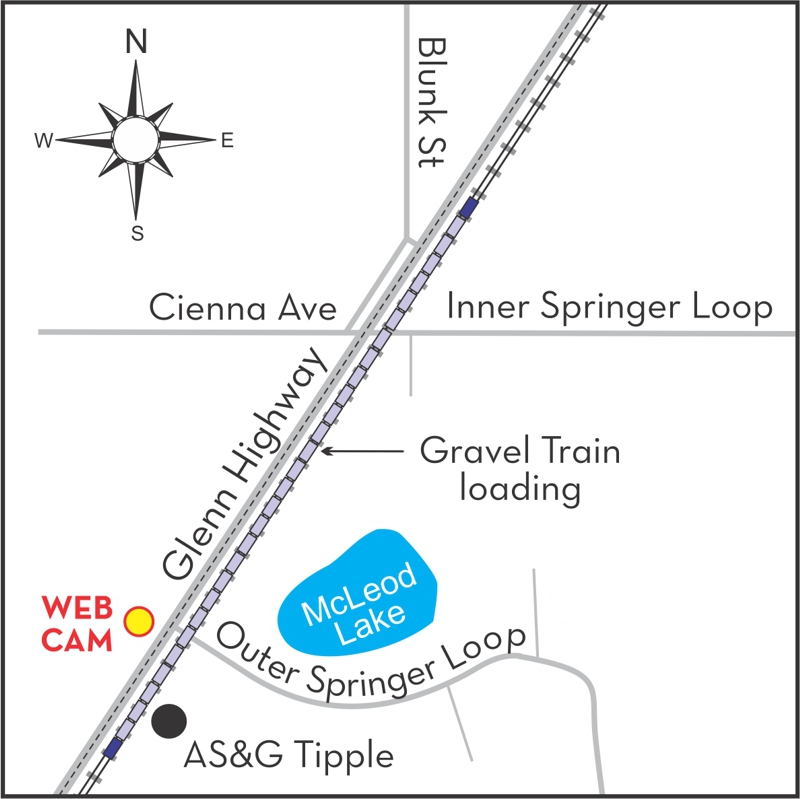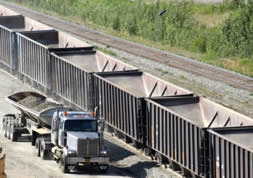What's Happening Now
Gravel Trains operating mid-April to October for 2025 season
Current gravel operations and their impact on traffic patterns
 From mid-April through mid-to-late October, Alaska Railroad gravel train movements will cause intermittent traffic delays at the C Street crossing (just north of the C Street and Raspberry Road intersection) in the late afternoon to early evening affecting evening rush hour traffic. Trains will run five to seven days per week. Flashing signs along C street notify motorists when the crossing is blocked with enough advance warning to use alternate routes to avoid delays. Traffic may choose to re-route to Arctic Blvd or through Minnesota Drive / Expressway and Old Seward Highway via Dimond Blvd, Dowling Road and International Airport Road. The gravel train schedule is dictated in part by the requirements of an Anchorage noise ordinance. Traffic delays of up to 15 minutes can be expected as each train must move over the crossing several times. Alaska Railroad gravel trains are also operating to other gravel customers on typical summer schedules.
From mid-April through mid-to-late October, Alaska Railroad gravel train movements will cause intermittent traffic delays at the C Street crossing (just north of the C Street and Raspberry Road intersection) in the late afternoon to early evening affecting evening rush hour traffic. Trains will run five to seven days per week. Flashing signs along C street notify motorists when the crossing is blocked with enough advance warning to use alternate routes to avoid delays. Traffic may choose to re-route to Arctic Blvd or through Minnesota Drive / Expressway and Old Seward Highway via Dimond Blvd, Dowling Road and International Airport Road. The gravel train schedule is dictated in part by the requirements of an Anchorage noise ordinance. Traffic delays of up to 15 minutes can be expected as each train must move over the crossing several times. Alaska Railroad gravel trains are also operating to other gravel customers on typical summer schedules.
In Palmer, beginning the mid-April, one train will operate six days per week then beginning April 21, 2025, 2 trains per day 6 days per week through most of May. As demand picks up, the schedule may increase to daily activity with one or two trains operating per day. Trains load at the AS&G tipple along the Palmer Branch Track in the morning (approximately 6-10 a.m.) and also in the evening (approximately 6-10 p.m.) on days there are two trains. Trains are approximately 12 hours apart. The railroad crossing over Outer Springer Loop will be blocked about three hours during loading. Inner Springer Loop will be blocked the last half hour of loading (expect delays 9-10 a.m./p.m.), but can otherwise be used for alternate access to the Glenn Highway. Grandview Circle will be blocked 10-20 minutes at the beginning of the loading process.
NOTE: The public can check to see if a gravel train is present along the track in the Springer Loop area by checking the AS&G webcam feed directly. Simply copy and paste the following URL into a browser, and the feed becomes visible, giving a real-time view of the track -- https://www.anchsand.com/springerroad
Filled gravel trains then unload in south Anchorage at the AS&G processing facility between Klatt and O'Malley roads in the afternoon and also in the early morning on days there are two trains (this is an industrial area and is not affected by noise ordinance restrictions.) During unloading, 104th Avenue can be blocked for up to an hour, and 100th Avenue may be blocked intermittently for 5-10 minutes. Short delays at Klatt and 120th may also occur during this unloading period as the train is split into two halves, maneuvers in and out of the siding, and reconnects. Motorists are encouraged to use 100th as an alternative most afternoons.
Below is background about the Alaska Railroad's gravel operations in the Anchorage Bowl and Mat-Su Valley. This includes information on alternative routes to avoid traffic delays.
Background on Summer 2025 Gravel Operations
The Alaska Railroad currently operates gravel trains in support of two customers that produce rock material, including gravel. Rock material is mined in the Mat-Su Valley (Kashwitna and Palmer) locations and hauled into processing facilities in Anchorage. A train crew runs an empty gravel train from Anchorage to a customer’s Mat-Su mining / production facility, where conveyor systems load the gravel into the railroad’s hopper cars in about 3 hours. The train returns to Anchorage where the gravel train is unloaded in about 3-4 hours. The empty train then heads back to the Mat-Su, beginning a new 10- to 12-hour operating cycle.

Impacted Road/Rail Crossings
Three Anchorage and two Palmer area public road/rail crossings are impacted more often by gravel train activity because the crossings are located nearby a gravel production or processing facility. Nearly a mile long, gravel trains are sometimes split into shorter segments while loading or unloading in order to accommodate traffic along highway crossings near the customer facility.
- C Street (Anchorage): ARRC operates one to two gravel trains per day, five to seven days per week, for a customer adjacent to C Street. City noise restrictions and the 10- to 12-hour gravel train cycle dictate the time the trains move over the crossing. When gravel demand requires two daily trains, the C Street crossing will be occupied intermittently in the morning and evening. When one train per day is required, the C Street crossing will be occupied intermittently in the late afternoon to early evening. This will occur around and during the evening rush hour. Arctic Blvd can normally be used as an alternate route.
- Klatt Road (Anchorage): During the afternoons, expect gravel trains to be maneuvering into and out of the rock/gravel processing facility between Klatt and O'Malley roads, causing short delays at Klatt and at 120th Avenue.
- 104th Avenue (Anchorage): During the afternoons, expect gravel trains to move very slowly over the 104th crossing as unloading occurs. Use 100th Avenue or C Street as an alternate route. The crossing may be blocked for up to an hour during the afternoons, daily and also in the morning when two trains per day are operating.
- 100th Avenue (Anchorage): During the afternoons, expect gravel trains to travel over this crossing for short periods. This crossing is not as affected by gravel unloading as is the case with 104th, so delays on 100th are shorter. Use Minnesota or Dimond as alternate routes.
- Springer Loop (Palmer): Expect delays in the morning for gravel train loading. Use Inner Springer Loop as an alternate route, although this road will also be blocked for about a half hour as the final cars of the train are loaded. The railroad, AS&G and the Alaska Dept. of Transportation (ADOT) teamed up to provide more information on when the Outer Springer crossing is blocked, to include DOT's 511 traffic advisory web site and call-in number, and a web video camera feed showing the crossing real-time.
- Grandview Circle (Palmer): Expect short delays (10-20 minutes) at the start of the loading process. This will be in the early morning and early evening time frame.
See public information and awareness communications efforts below to keep the motorists and residents informed about Gravel Train movements and potential traffic impacts:
Public Notice & Communications
511 Alaska Traveler Information
- 511 WEBSITE: http://511.alaska.gov. In the top-right corner, select Mat-Su on the locator drop-down to view the Mat-Su Area map. In the Legend Box, check the the "Mileposts" and "Roadwork / Maintenance" items. Use +/- to enlarge the map to view the Glenn Highway between Mileposts 38 and 40. Click the Maintenance icons near intersections with Outer Springer Loop and Inner Springer Loop to see details.
- 511 PHONE: Dial 5-1-1 from inside Alaska. Say “Glenn Highway” then “southbound” then “Palmer” for gravel train activity impacting Glenn Highway traffic between MP 38-40. The Gravel Train Activity item will be provided orally over the phone.
- 511 MOBILES APPS: Download the Alaska 511 app for Android (Google Play) or iPhone (Apple App Store). The 511 mobile site is available on most smartphone browsers.
Newspaper advertisement: An ad to notify / remind Mat-Su residents of gravel train traffic is published multiple times as the season gets underway.
Local Resident Informational Flyer: Additional details are included in this flyer sent to Springer Loop Area residents in early May
 Gravel Operations Web Camera
Gravel Operations Web Camera
An AS&G web camera aimed at the Outer Springer crossing provides real-time video feeds viewable online on a computer, smart phone or other internet-connected device. Simply type the following URL into a browser:
AS&G's webcam is located on the west side of the Glenn Highway, across from the highway's intersection with Outer Springer Loop. The camera view is northeast toward the Glenn Highway / Outer Springer, allowing viewers to see if a gravel train is present on the Palmer Rail Branch.
Gravel Scheduling

A number of factors influence gravel train scheduling:
Noise Ordinance: Some gravel/rock production facilities cannot unload gravel trains between 10 p.m. and 6 a.m. due to a city noise ordinance. A daytime unloading schedule is used for these customers. A night-time unloading schedule may be used at facilities that are not subject to a noise ordinance. This day/night cycle is not always possible if one customer requires two gravel trains per day.
Passenger / Freight Train Schedules: Activity on the track increases in the summer with the addition of daily passenger and gravel trains, as well as work trains and heavy equipment used for track maintenance. Between South Anchorage and the Mat-Su area, up to 30 different types of train movements can occur on any given day. This poses a daily challenge, because changing the train movement schedule at one location directly impacts the time the same train passes through at another location. Gravel trains must frequently pull into sidings to allow other trains to pass. The Alaska Railroad strives to meet train customer needs, while minimizing negative impacts to the traveling public. Even so, some conflicts are inevitable and unavoidable.
Cost-efficiency: The capital cost to purchase one 86-car gravel train consist is nearly $10 million. To be cost-effective, it is essential for each gravel train to cycle twice per day. Inefficient single-cycle gravel operations would lead to higher costs to our customers and ultimately to the public consumers.
Gravel Economics
Gravel train activity signals economic activity. The Alaska Railroad expects to move more than 1 million tons of gravel in 2025. Similar to road construction, important capital projects can result in some inconvenience to the traveling public. The upshot is improved infrastructure and good-paying job opportunities for Alaskans.
Gravel hauled by the railroad supports road, airport and commercial construction. A typical gravel train consists of two SD70MAC locomotives pulling 86 hopper cars, and can haul about 8,600 tons of material. Train transport remains one of the most economical, least disruptive, and safest ways to move gravel. Hauling 2.5 million tons of material requires about 290 trains, which is roughly equivalent to about 96,000 26-ton truck loads (192,000 one-way truck trips).
Working with Communities to Resolve Traffic & Noise Conflicts
The Alaska Railroad continues a long tradition of working with communities, neighborhoods, customers and the general public to refine gravel and other train schedules to accommodate concerns and customers, while considering safety. While it is not possible to develop a schedule that solves all traffic and noise concerns, many of our efforts have reduced impacts or have revealed local and state infrastructure investments that could further reduce or even eliminate such conflicts. These fact sheets outline some of these efforts:
Anchorage: C Street Crossing Challenges
Anchorage: Public Crossings Quiet Zone

